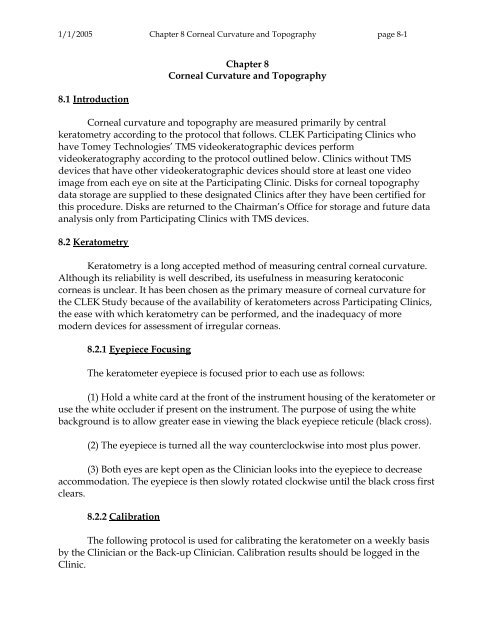OM t of c.iii - Vision Research Coordinating Center - Washington ...
OM t of c.iii - Vision Research Coordinating Center - Washington ...
OM t of c.iii - Vision Research Coordinating Center - Washington ...
Create successful ePaper yourself
Turn your PDF publications into a flip-book with our unique Google optimized e-Paper software.
1/1/2005 Chapter 8 Corneal Curvature and Topography page 8-1<br />
8.1 Introduction<br />
Chapter 8<br />
Corneal Curvature and Topography<br />
Corneal curvature and topography are measured primarily by central<br />
keratometry according to the protocol that follows. CLEK Participating Clinics who<br />
have Tomey Technologies’ TMS videokeratographic devices perform<br />
videokeratography according to the protocol outlined below. Clinics without TMS<br />
devices that have other videokeratographic devices should store at least one video<br />
image from each eye on site at the Participating Clinic. Disks for corneal topography<br />
data storage are supplied to these designated Clinics after they have been certified for<br />
this procedure. Disks are returned to the Chairman’s Office for storage and future data<br />
analysis only from Participating Clinics with TMS devices.<br />
8.2 Keratometry<br />
Keratometry is a long accepted method <strong>of</strong> measuring central corneal curvature.<br />
Although its reliability is well described, its usefulness in measuring keratoconic<br />
corneas is unclear. It has been chosen as the primary measure <strong>of</strong> corneal curvature for<br />
the CLEK Study because <strong>of</strong> the availability <strong>of</strong> keratometers across Participating Clinics,<br />
the ease with which keratometry can be performed, and the inadequacy <strong>of</strong> more<br />
modern devices for assessment <strong>of</strong> irregular corneas.<br />
8.2.1 Eyepiece Focusing<br />
The keratometer eyepiece is focused prior to each use as follows:<br />
(1) Hold a white card at the front <strong>of</strong> the instrument housing <strong>of</strong> the keratometer or<br />
use the white occluder if present on the instrument. The purpose <strong>of</strong> using the white<br />
background is to allow greater ease in viewing the black eyepiece reticule (black cross).<br />
(2) The eyepiece is turned all the way counterclockwise into most plus power.<br />
(3) Both eyes are kept open as the Clinician looks into the eyepiece to decrease<br />
accommodation. The eyepiece is then slowly rotated clockwise until the black cross first<br />
clears.<br />
8.2.2 Calibration<br />
The following protocol is used for calibrating the keratometer on a weekly basis<br />
by the Clinician or the Back-up Clinician. Calibration results should be logged in the<br />
Clinic.
















